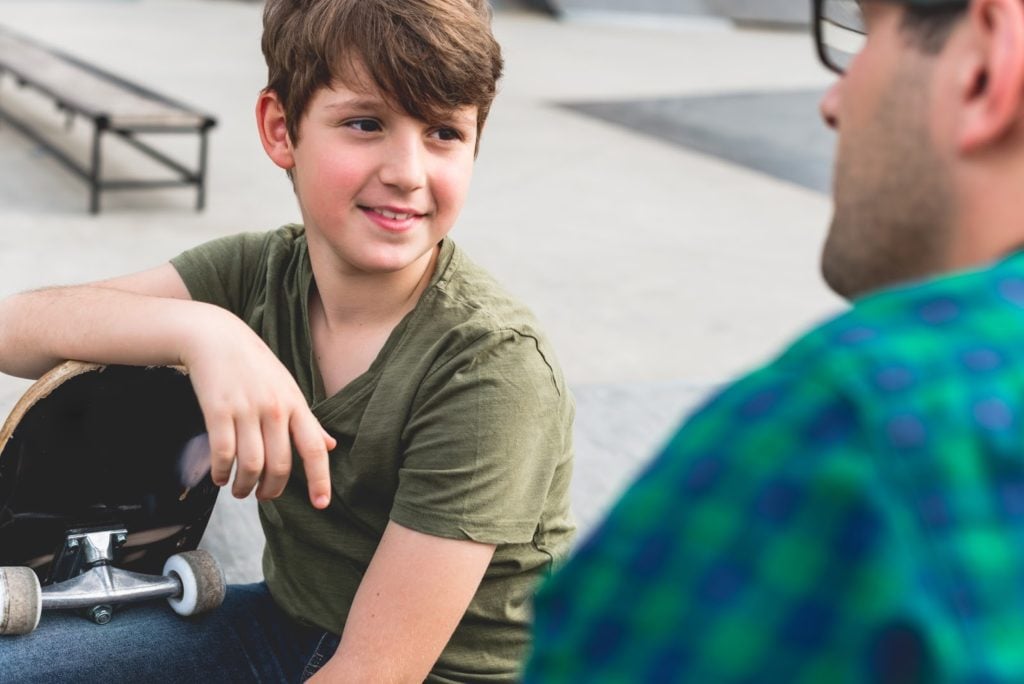Figuring out how to talk to teenagers can be tricky. Here are 10 tips designed to transform your conversations.
Talking to teenagers about anything serious can be one of those bang-your-head-against-a-wall activities. It feels good when you stop. They are great at banter, jokes and even flirting, but trying to get to the bottom of an emotional problem can be painful…for everyone involved.
Many teens don’t like ‘deep’ conversations, at least not with a parent or teacher. You can abandon everything you’ve learnt about open, honest body language. The minute you sit them down and try to engage them in face to face discussion, with eye contact…you’re done. They are likely to shut down. So, how do you ever figure out what’s on their mind?
There’s a Time and a Place to Talk to Teenagers
I learnt early on that if I could get teenagers busy and moving and working by my side, there was a decent chance that we could get somewhere. I’m sure many of you have noticed the same thing. Psychologists call it side-by side-listening.
I was an English teacher. That involves carrying a lot of books from bookrooms to classrooms and back again. Most of the book carrying that I had kids help me with was completely unnecessary. Some of those books travelled so far they should have had passports. But it did the trick.
The kids felt as though they were helping me, they were moving so they didn’t feel trapped, and we were side by side, so there was no intimidating eye contact. I don’t feel bad about the ruse. We were going to have those talks anyway, side by side was just a better way.
Other side-by-side activities I’ve used are peeling potatoes, washing dishes, cleaning the car, hiking and shooting hoops. Some people advocate talking while travelling in the car and I’m sure it works for some people.
I just remember that my mum used to give me sex ed chats while we were driving and I felt trapped. There were times I would have thrown myself out of the moving car if I thought that would stop her talking. So really you have to choose the right activity for the child.
It’s All About Relationship…
Resilient Youth Australia report that in a sample of over 91,000 Australian children, 32% of Years 7 – 8 students and 39% of Years 9 – 10 say they cannot identify an adult in their lives who listens to them. Whether these figures represent reality or perception is interesting, but ultimately irrelevant. It is their experience of the world. Maybe it is not that we don’t want to listen as much as that we don’t know how to get them to start talking.
It helps to have a shared interest with a child, like surfing or dance or cooking or a football team or absolutely anything. It’s important because it builds a bond and because talking about the interest leads to talking about other things.
A shared interest is a touchstone and a starting point. A shared interest can also carry you through the uncommunicative teenage years and out the other side. Through those years you can retain a connection that would otherwise be hard to establish.
In building communication try to amplify the positives. Don’t talk just when there are negatives to be discussed. Show genuine interest. If a child can come to you with positive things and be reinforced, there is more of a chance that they will approach you with more difficult topics.
The old adage is true, take note of the little things when children are young, so that they will come to you with the big things when they are older. Because to them, they’ve all been big things.
10 Skills Adults Need In Order To Talk To Teenagers
1. Choose an appropriate context. It’s all about the right time and the right place. If you are rushed or stressed yourself, don’t even try. If it is important enough to talk about, it is important enough to create the right situation to talk. Remember, movement helps.
2. Sit with discomfort. It’s not just kids who feel uncomfortable with serious conversations or conversations about feelings. Even if we feel uncomfortable, we need to be okay about feeling uncomfortable.
3. Use I statements. The reason for using I statements is that they avoid telling someone how they feel and they allow for clarification. Santa Maria College Psychologist Beth O’Regan gives this example, “I’ve noticed that you’ve stopped playing basketball and haven’t been spending as much time with your friends lately, and I’m worried because that’s out of character for you.” State a behaviour you’ve seen or noticed, and follow up with how it makes you feel and why. That can then lead onto a question like, “Is there something going on for you right now that you’d like to talk about?”
4. Beth also says, it’s important to be genuine and authentic. It’s ok to admit that you find a particular topic difficult to talk about. Also within this realm, be aware of your language, and only use language you are comfortable with. If you try to use slang or phrases you don’t normally use in an attempt to speak in the same way as the young person, they will be able to tell immediately and it may have the opposite effect of creating a barrier, rather than removing one.
5. Don’t interrupt. Once you get a teenager talking, don’t interrupt. Let them explain whole ideas. Sometimes they will talk themselves into an understanding of how they feel or what they need to do, just by virtue of having to articulate it. At the very least you will have a complete picture of what they are trying to communicate. The good stuff often comes at the end.
6. Give your teen time to think, not just speak. Be comfortable with pauses. Don’t feel as though you need to fill the dead air.
7. Suspend judgment. This is hard, but how you react determines whether or not the conversation continues. You don’t have to agree with what is being said, but don’t shut it down verbally, with emotional responses or with body language.
8. When you get to the essence of the conversation, paraphrase or repeat in order to clarify your understanding. Just because you think you understand, doesn’t mean you do. Check.
9. Ask yourself, am I listening to understand? Or am I listening to comment or fix it? It makes a big difference when we listen just to understand.
10. Finally, remember…sometimes kids don’t know how they feel or why they do the things they do. They just do. They will show you how they feel through their actions. If they feel under siege they may be aggressive or close up. If they are sad they may show the secondary emotion of anger. If that’s the case, we need to listen with our eyes and our experience and our hearts. Tread gently.
Linda would love to meet you on her Facebook page here









